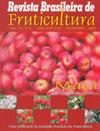香蕉“Prata anã”对采后施亚磷酸盐的反应
IF 0.9
4区 农林科学
Q4 HORTICULTURE
引用次数: 1
摘要
摘要本研究旨在确定控制炭疽病的最佳亚磷酸酯源和浓度及其对“Prata-anã”香蕉理化特性的影响。将香蕉花束浸泡在含有不同配方的亚硫酸铜FCu1 (4% Cu + 20% P2O5)、FCu2 (4% Cu + 22% P2O5)的溶液中,浓度为0.5;1.0、1.5和2.0 ml L-1和亚磷酸钾FK (42% P2O5 + 27.7% K2O),浓度为0.5;1.0, 1.5和2.0 mg L-1。对照组为纯净水和依马唑利(0.5 mL. L-1)。随后每3天评估一次炭疽病的发病率和严重程度。在炭疽病强度评价结束时,对果实的理化特性进行评价。采用完全随机的实验设计。结果表明,不同亚硝酸盐源FCu1、FCu2和FK对炭疽病的防治效果均不显著。不同亚磷酸盐来源和浓度对果实理化特性有影响。新鲜水果的质量损失与施用的亚硝酸盐浓度成正比。本文章由计算机程序翻译,如有差异,请以英文原文为准。
Response of ‘Prata anã’ banana to post-harvest phosphite application
Abstract The objective of the present study was to determine the best phosphite source and concentration to control anthracnose and its effects on the physical and chemical characteristics of ‘Prata-anã’ banana. Bouquets of banana fruits were immersed in solutions containing different formulations of copper phosphite FCu1 (4% Cu + 20% P2O5), FCu2 (4% Cu + 22% P2O5) at concentrations of 0.5; 1.0, 1.5- and 2.0-mL L-1 and potassium phosphite FK (42% P2O5 + 27.7% K2O) at concentrations of 0.5; 1.0, 1.5 and 2.0 mg L-1. Controls consisted of the application of pure water and Imazalil application (0.5 mL. L-1). Subsequently, anthracnose incidence and severity were evaluated every three days. The physical and chemical characteristics of fruits were evaluated at the end of the anthracnose intensity evaluation. The experimental design used was completely randomized. The results showed that the different phosphite sources FCu1, FCu2 and FK at the concentrations tested were not effective in controlling anthracnose. The physical and chemical characteristics of fruits were influenced by the different phosphite sources and concentrations applied. Fresh fruit mass loss is proportional to the applied phosphite concentration.
求助全文
通过发布文献求助,成功后即可免费获取论文全文。
去求助
来源期刊
CiteScore
1.50
自引率
20.00%
发文量
34
审稿时长
4-8 weeks
期刊介绍:
The Revista Brasileira de Fruticultura (RBF) publishes technical articles and scientific communications in the area of fruit crops, referring to results of original searches and unpublished papers in Portuguese, Spanish or English, and 1 or 2 reviews per edition, of invited authors.

 求助内容:
求助内容: 应助结果提醒方式:
应助结果提醒方式:


